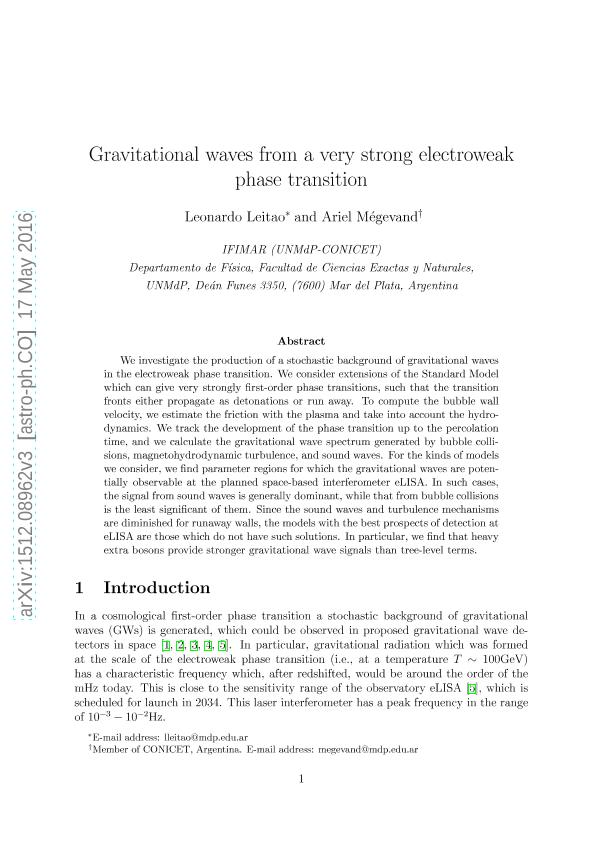Mostrar el registro sencillo del ítem
dc.contributor.author
Leitao, Leonardo

dc.contributor.author
Megevand, Ariel Hugo

dc.date.available
2018-10-23T19:24:51Z
dc.date.issued
2016-05
dc.identifier.citation
Leitao, Leonardo; Megevand, Ariel Hugo; Gravitational waves from a very strong electroweak phase transition; IOP Publishing; Journal of Cosmology and Astroparticle Physics; 2016; 5; 5-2016; 1-30
dc.identifier.issn
1475-7516
dc.identifier.uri
http://hdl.handle.net/11336/62945
dc.description.abstract
We investigate the production of a stochastic background of gravitational waves in the electroweak phase transition. We consider extensions of the Standard Model which can give very strongly first-order phase transitions, such that the transition fronts either propagate as detonations or run away. To compute the bubble wall velocity, we estimate the friction with the plasma and take into account the hydrodynamics. We track the development of the phase transition up to the percolation time, and we calculate the gravitational wave spectrum generated by bubble collisions, magnetohydrodynamic turbulence, and sound waves. For the kinds of models we consider, we find parameter regions for which the gravitational waves are potentially observable at the planned space-based interferometer eLISA. In such cases, the signal from sound waves is generally dominant, while that from bubble collisions is the least significant of them. Since the sound waves and turbulence mechanisms are diminished for runaway walls, the models with the best prospects of detection at eLISA are those which do not have such solutions. In particular, we find that heavy extra bosons provide stronger gravitational wave signals than tree-level terms.
dc.format
application/pdf
dc.language.iso
eng
dc.publisher
IOP Publishing

dc.rights
info:eu-repo/semantics/openAccess
dc.rights.uri
https://creativecommons.org/licenses/by-nc-sa/2.5/ar/
dc.subject
Cosmological Phase Transitions
dc.subject
Cosmology Of Theories Beyond the Sm
dc.subject
Gravitational Waves / Sources
dc.subject.classification
Astronomía

dc.subject.classification
Ciencias Físicas

dc.subject.classification
CIENCIAS NATURALES Y EXACTAS

dc.title
Gravitational waves from a very strong electroweak phase transition
dc.type
info:eu-repo/semantics/article
dc.type
info:ar-repo/semantics/artículo
dc.type
info:eu-repo/semantics/publishedVersion
dc.date.updated
2018-10-23T13:45:46Z
dc.journal.volume
2016
dc.journal.number
5
dc.journal.pagination
1-30
dc.journal.pais
Reino Unido

dc.journal.ciudad
Bristol
dc.description.fil
Fil: Leitao, Leonardo. Consejo Nacional de Investigaciones Científicas y Técnicas. Centro Científico Tecnológico Conicet - Mar del Plata. Instituto de Investigaciones Físicas de Mar del Plata. Universidad Nacional de Mar del Plata. Facultad de Ciencias Exactas y Naturales. Instituto de Investigaciones Físicas de Mar del Plata; Argentina
dc.description.fil
Fil: Megevand, Ariel Hugo. Consejo Nacional de Investigaciones Científicas y Técnicas. Centro Científico Tecnológico Conicet - Mar del Plata. Instituto de Investigaciones Físicas de Mar del Plata. Universidad Nacional de Mar del Plata. Facultad de Ciencias Exactas y Naturales. Instituto de Investigaciones Físicas de Mar del Plata; Argentina
dc.journal.title
Journal of Cosmology and Astroparticle Physics

dc.relation.alternativeid
info:eu-repo/semantics/altIdentifier/doi/http://dx.doi.org/10.1088/1475-7516/2016/05/037
dc.relation.alternativeid
info:eu-repo/semantics/altIdentifier/url/http://iopscience.iop.org/article/10.1088/1475-7516/2016/05/037/meta
dc.relation.alternativeid
info:eu-repo/semantics/altIdentifier/url/https://arxiv.org/abs/1512.08962
Archivos asociados
